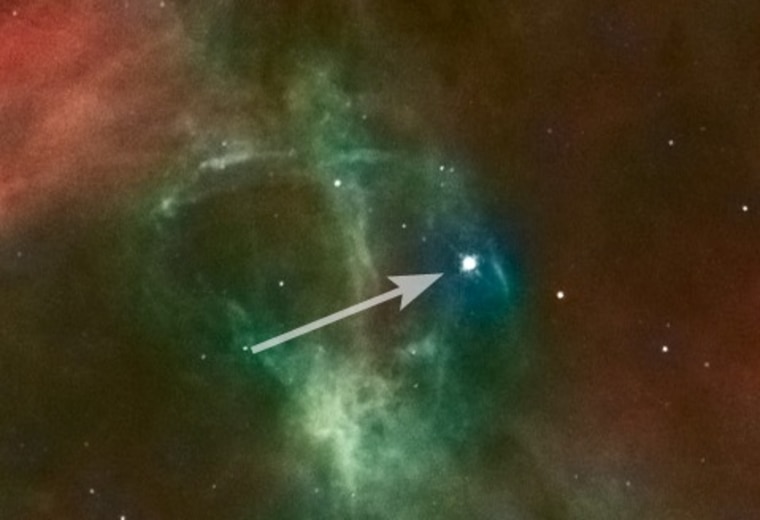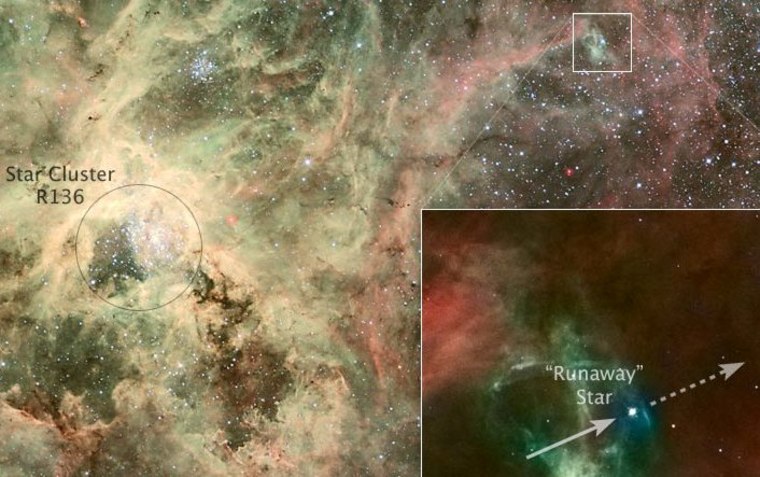A massive runaway star has been spotted by the Hubble Space Telescope racing away from its stellar nursery after being kicked out by some of its much heftier stellar siblings.
The homeless star is on the outer fringes of 30 Doradus Nebula — commonly known as the Tarantula Nebula — a teeming stellar breeding ground in the Milky Way's nearby galactic neighbor, the Large Magellanic Cloud.
The star, which is about 90 times as massive as our own sun, is racing through space at a speed of about 250,000 mph (400,000 kilometers per hour), a speed that would get you to the moon and back in about two hours.
Tantalizing clues from three observatories, including the Hubble Space Telescope's newly installed Cosmic Origins Spectrograph (COS), along with some old-fashioned detective work, suggest that the star may have traveled about 375 light-years from its suspected home — a giant star cluster called R136. (One light-year is the distance that light can travel in one year, about 6 trillion miles or 10 trillion kilometers.)
The finding is yet more evidence that the most massive stars in the local universe can be found in the Tarantula Nebula, making it a unique laboratory for studying heavyweight stars. R136 is nestled inside the Tarantula Nebula, which is located 170,000 light-years from Earth and contains several stars topping 100 solar masses each.
How massive clusters behave
The new observations offer insights into how massive star clusters behave.
"These results are of great interest because such dynamical processes in very dense, massive clusters have been predicted theoretically for some time, but this is the first direct observation of the process in such a region," said Nolan Walborn of the Space Telescope Science Institute in Baltimore, Md., and a member of the COS team that observed the misfit star.

Less massive runaway stars from the much smaller Orion Nebula Cluster were first found over half a century ago, but this is the first potential confirmation of more recent predictions applying to the most massive young clusters," Walborn said.
Runaway stars can form in one of two ways. A star may encounter one or two heavier siblings in a massive, dense cluster and get booted out through a stellar game of pinball. Or a star may get a supercharged cosmic kick from a supernova explosion in a binary system, with the more massive star exploding first.
The first process is suspected to have sent this particular star packing.
"It is generally accepted, however, that R136 is young enough that the cluster's most massive stars have not yet exploded as supernovae," said COS team member Danny Lennon, also of the Space Telescope Science Institute. "This implies that the star must have been ejected through dynamical interaction."
Hot on the trail
Astronomers have been tracking this rogue star since 2006 when a team led by Ian Howarth of University College in London spotted it with the Anglo-Australian Telescope at the Siding Spring Observatory in Australia.
That observation revealed that the stellar misfit is an exceptionally hot, massive blue-white star that is relatively far from any cluster in which such stars are typically found.
Slideshow 12 photos
Month in Space: January 2014
Hubble astronomers then picked up another clue when they used the star as a target to calibrate the COS instrument, which was installed on Hubble in May 2009 during final servicing mission to the joint NASA-European Space Agency space telescope.
It was those ultraviolet spectroscopic observations, performed in July 2009, which showed that the wayward star is unleashing a fury of charged particles in one of the most powerful stellar winds known, researchers said. That was a clear sign that it is extremely massive, perhaps as much as 90 times heavier than the sun, they added.
The star, therefore, also must be very young, about one million to two million years old, because extremely massive stars only live for a few million years, Hubble researchers said.
The new observations of the star are detailed in the May 5 online edition of The Astrophysical Journal Letters.
The renegade star may not be the only runaway in the region.
Two other extremely hot, massive stars have been spotted beyond the edges of the Tarantula Nebula. Astronomers suspect that these stars may also have been ejected from their home. They plan to analyze the departing stars in detail to determine if the nebula is unleashing a barrage of massive stellar runaways into its surrounding neighborhood.
Meanwhile, the wayward star R136 will continue to streak across space, said team member Paul Crowther of the University of Sheffield in England. It should eventually end its life in a titanic supernova explosion, likely leaving behind a remnant black hole, he added.

